BTEC HND Health and Social Care: Managing Human Resources Report
VerifiedAdded on 2020/10/04
|11
|3231
|32
Report
AI Summary
This report examines the critical aspects of managing human resources within the health and social care sector, focusing on Silver Meadows, an organization operating in this field. The report begins by exploring factors to consider during recruitment planning, including internal policies, skill assessment, and advertising strategies. It then delves into the influence of legislative frameworks, such as the Employment Rights Act, on the selection process, emphasizing anti-discrimination rules and the importance of fair practices. The report further analyzes various approaches to ensure effective recruitment, such as interviews, auditions, and psychometric assessments. It also investigates theories of individual interaction within groups, specifically Tuckman's model, and methods for developing effective team working through formal and informal groups. Furthermore, the report discusses methods for monitoring staff performance, identifying training needs, and promoting continuous development. Finally, it covers leadership theories applicable to the health and social care workplace, including relational, transformational, and Fiedler's contingency models, providing a comprehensive overview of HR management in this sector.
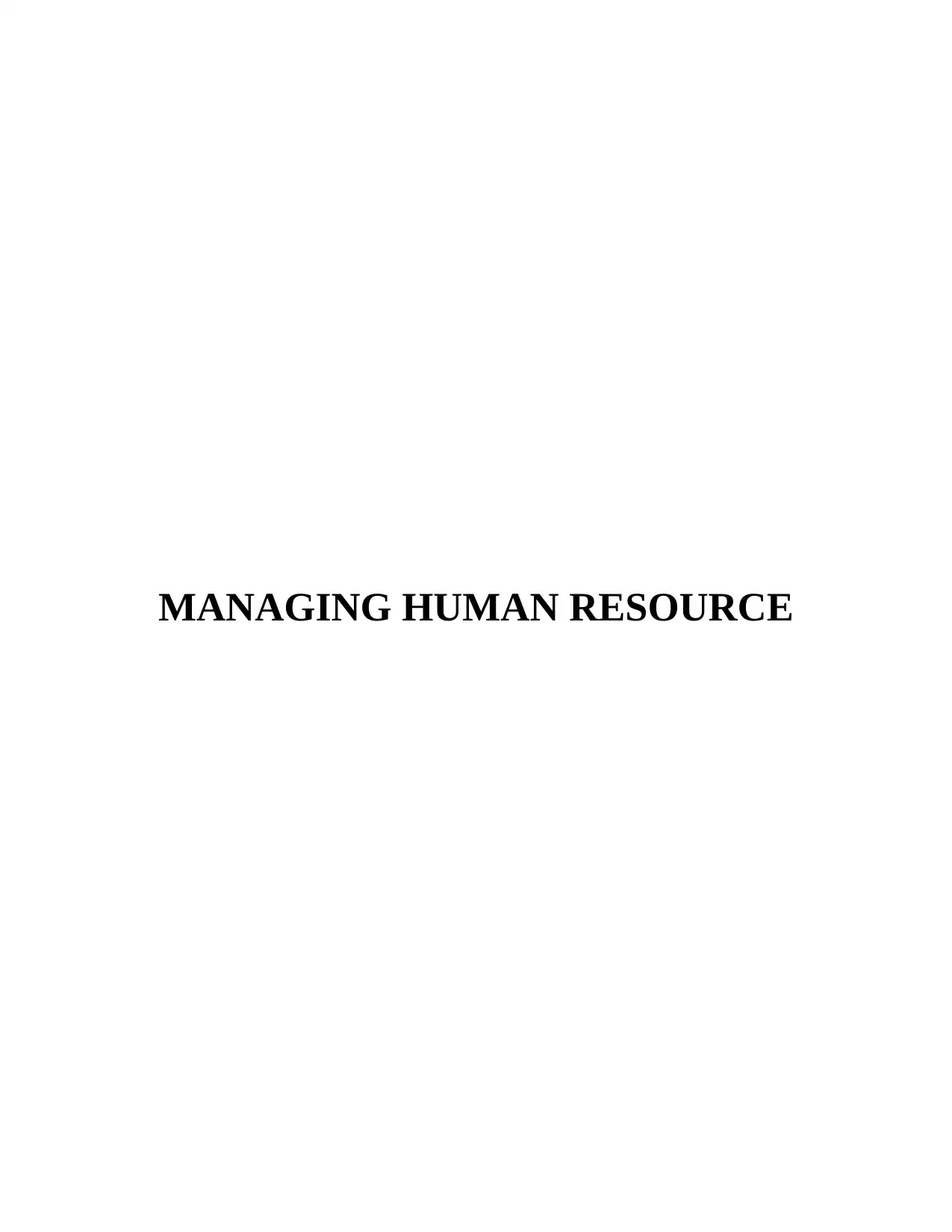
MANAGING HUMAN RESOURCE
Paraphrase This Document
Need a fresh take? Get an instant paraphrase of this document with our AI Paraphraser
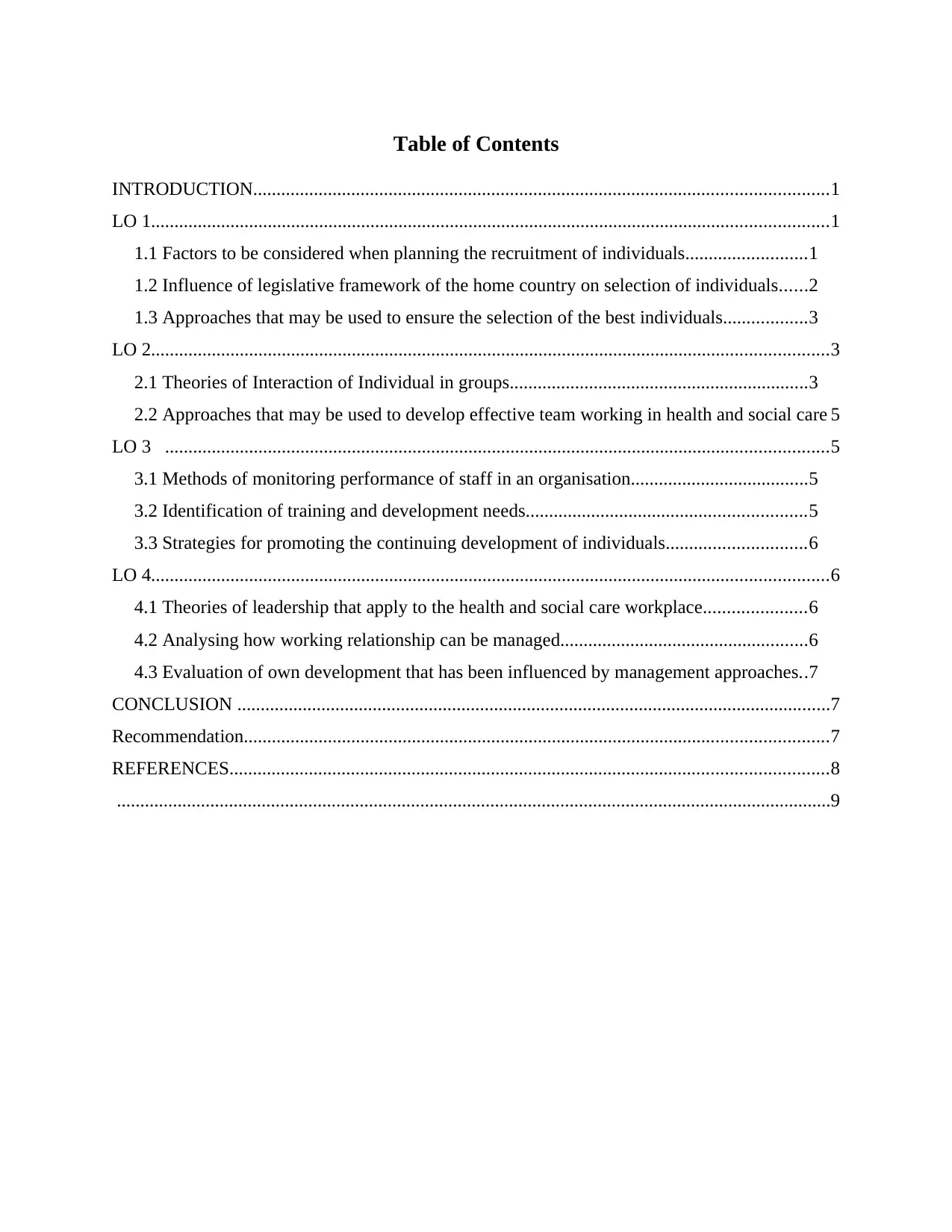
Table of Contents
INTRODUCTION...........................................................................................................................1
LO 1.................................................................................................................................................1
1.1 Factors to be considered when planning the recruitment of individuals..........................1
1.2 Influence of legislative framework of the home country on selection of individuals......2
1.3 Approaches that may be used to ensure the selection of the best individuals..................3
LO 2.................................................................................................................................................3
2.1 Theories of Interaction of Individual in groups................................................................3
2.2 Approaches that may be used to develop effective team working in health and social care 5
LO 3 ..............................................................................................................................................5
3.1 Methods of monitoring performance of staff in an organisation......................................5
3.2 Identification of training and development needs............................................................5
3.3 Strategies for promoting the continuing development of individuals..............................6
LO 4.................................................................................................................................................6
4.1 Theories of leadership that apply to the health and social care workplace......................6
4.2 Analysing how working relationship can be managed.....................................................6
4.3 Evaluation of own development that has been influenced by management approaches..7
CONCLUSION ...............................................................................................................................7
Recommendation.............................................................................................................................7
REFERENCES................................................................................................................................8
.........................................................................................................................................................9
INTRODUCTION...........................................................................................................................1
LO 1.................................................................................................................................................1
1.1 Factors to be considered when planning the recruitment of individuals..........................1
1.2 Influence of legislative framework of the home country on selection of individuals......2
1.3 Approaches that may be used to ensure the selection of the best individuals..................3
LO 2.................................................................................................................................................3
2.1 Theories of Interaction of Individual in groups................................................................3
2.2 Approaches that may be used to develop effective team working in health and social care 5
LO 3 ..............................................................................................................................................5
3.1 Methods of monitoring performance of staff in an organisation......................................5
3.2 Identification of training and development needs............................................................5
3.3 Strategies for promoting the continuing development of individuals..............................6
LO 4.................................................................................................................................................6
4.1 Theories of leadership that apply to the health and social care workplace......................6
4.2 Analysing how working relationship can be managed.....................................................6
4.3 Evaluation of own development that has been influenced by management approaches..7
CONCLUSION ...............................................................................................................................7
Recommendation.............................................................................................................................7
REFERENCES................................................................................................................................8
.........................................................................................................................................................9
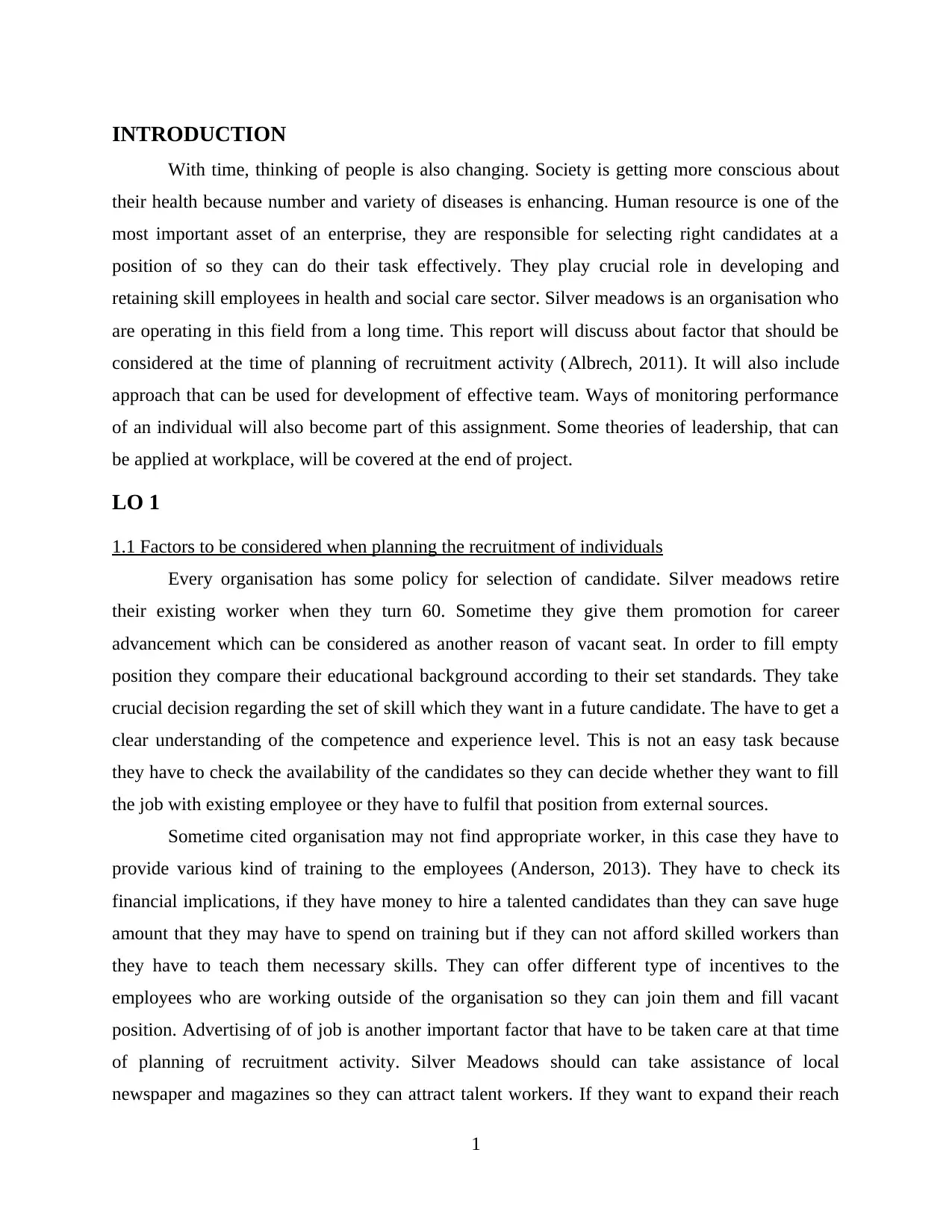
INTRODUCTION
With time, thinking of people is also changing. Society is getting more conscious about
their health because number and variety of diseases is enhancing. Human resource is one of the
most important asset of an enterprise, they are responsible for selecting right candidates at a
position of so they can do their task effectively. They play crucial role in developing and
retaining skill employees in health and social care sector. Silver meadows is an organisation who
are operating in this field from a long time. This report will discuss about factor that should be
considered at the time of planning of recruitment activity (Albrech, 2011). It will also include
approach that can be used for development of effective team. Ways of monitoring performance
of an individual will also become part of this assignment. Some theories of leadership, that can
be applied at workplace, will be covered at the end of project.
LO 1
1.1 Factors to be considered when planning the recruitment of individuals
Every organisation has some policy for selection of candidate. Silver meadows retire
their existing worker when they turn 60. Sometime they give them promotion for career
advancement which can be considered as another reason of vacant seat. In order to fill empty
position they compare their educational background according to their set standards. They take
crucial decision regarding the set of skill which they want in a future candidate. The have to get a
clear understanding of the competence and experience level. This is not an easy task because
they have to check the availability of the candidates so they can decide whether they want to fill
the job with existing employee or they have to fulfil that position from external sources.
Sometime cited organisation may not find appropriate worker, in this case they have to
provide various kind of training to the employees (Anderson, 2013). They have to check its
financial implications, if they have money to hire a talented candidates than they can save huge
amount that they may have to spend on training but if they can not afford skilled workers than
they have to teach them necessary skills. They can offer different type of incentives to the
employees who are working outside of the organisation so they can join them and fill vacant
position. Advertising of of job is another important factor that have to be taken care at that time
of planning of recruitment activity. Silver Meadows should can take assistance of local
newspaper and magazines so they can attract talent workers. If they want to expand their reach
1
With time, thinking of people is also changing. Society is getting more conscious about
their health because number and variety of diseases is enhancing. Human resource is one of the
most important asset of an enterprise, they are responsible for selecting right candidates at a
position of so they can do their task effectively. They play crucial role in developing and
retaining skill employees in health and social care sector. Silver meadows is an organisation who
are operating in this field from a long time. This report will discuss about factor that should be
considered at the time of planning of recruitment activity (Albrech, 2011). It will also include
approach that can be used for development of effective team. Ways of monitoring performance
of an individual will also become part of this assignment. Some theories of leadership, that can
be applied at workplace, will be covered at the end of project.
LO 1
1.1 Factors to be considered when planning the recruitment of individuals
Every organisation has some policy for selection of candidate. Silver meadows retire
their existing worker when they turn 60. Sometime they give them promotion for career
advancement which can be considered as another reason of vacant seat. In order to fill empty
position they compare their educational background according to their set standards. They take
crucial decision regarding the set of skill which they want in a future candidate. The have to get a
clear understanding of the competence and experience level. This is not an easy task because
they have to check the availability of the candidates so they can decide whether they want to fill
the job with existing employee or they have to fulfil that position from external sources.
Sometime cited organisation may not find appropriate worker, in this case they have to
provide various kind of training to the employees (Anderson, 2013). They have to check its
financial implications, if they have money to hire a talented candidates than they can save huge
amount that they may have to spend on training but if they can not afford skilled workers than
they have to teach them necessary skills. They can offer different type of incentives to the
employees who are working outside of the organisation so they can join them and fill vacant
position. Advertising of of job is another important factor that have to be taken care at that time
of planning of recruitment activity. Silver Meadows should can take assistance of local
newspaper and magazines so they can attract talent workers. If they want to expand their reach
1
⊘ This is a preview!⊘
Do you want full access?
Subscribe today to unlock all pages.

Trusted by 1+ million students worldwide
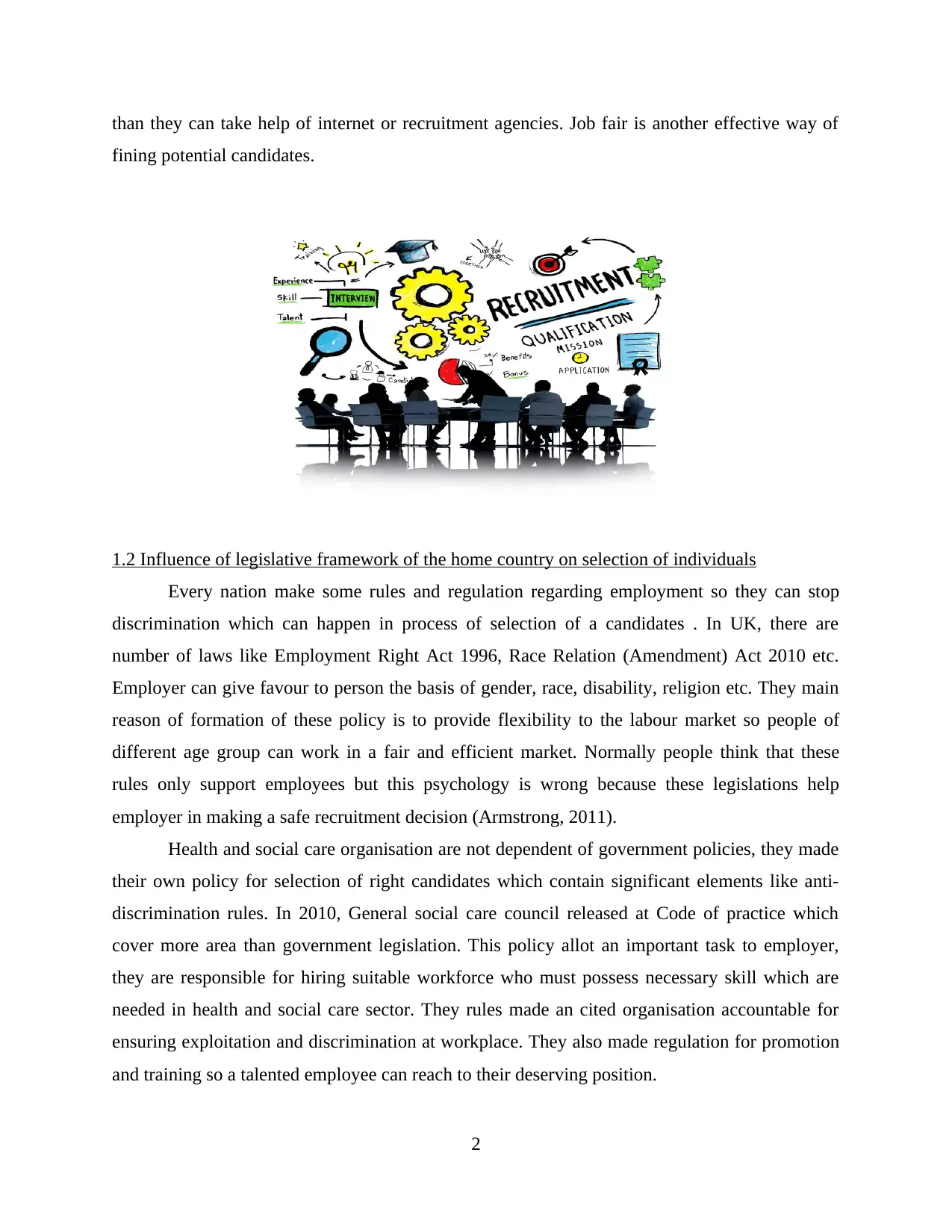
than they can take help of internet or recruitment agencies. Job fair is another effective way of
fining potential candidates.
1.2 Influence of legislative framework of the home country on selection of individuals
Every nation make some rules and regulation regarding employment so they can stop
discrimination which can happen in process of selection of a candidates . In UK, there are
number of laws like Employment Right Act 1996, Race Relation (Amendment) Act 2010 etc.
Employer can give favour to person the basis of gender, race, disability, religion etc. They main
reason of formation of these policy is to provide flexibility to the labour market so people of
different age group can work in a fair and efficient market. Normally people think that these
rules only support employees but this psychology is wrong because these legislations help
employer in making a safe recruitment decision (Armstrong, 2011).
Health and social care organisation are not dependent of government policies, they made
their own policy for selection of right candidates which contain significant elements like anti-
discrimination rules. In 2010, General social care council released at Code of practice which
cover more area than government legislation. This policy allot an important task to employer,
they are responsible for hiring suitable workforce who must possess necessary skill which are
needed in health and social care sector. They rules made an cited organisation accountable for
ensuring exploitation and discrimination at workplace. They also made regulation for promotion
and training so a talented employee can reach to their deserving position.
2
fining potential candidates.
1.2 Influence of legislative framework of the home country on selection of individuals
Every nation make some rules and regulation regarding employment so they can stop
discrimination which can happen in process of selection of a candidates . In UK, there are
number of laws like Employment Right Act 1996, Race Relation (Amendment) Act 2010 etc.
Employer can give favour to person the basis of gender, race, disability, religion etc. They main
reason of formation of these policy is to provide flexibility to the labour market so people of
different age group can work in a fair and efficient market. Normally people think that these
rules only support employees but this psychology is wrong because these legislations help
employer in making a safe recruitment decision (Armstrong, 2011).
Health and social care organisation are not dependent of government policies, they made
their own policy for selection of right candidates which contain significant elements like anti-
discrimination rules. In 2010, General social care council released at Code of practice which
cover more area than government legislation. This policy allot an important task to employer,
they are responsible for hiring suitable workforce who must possess necessary skill which are
needed in health and social care sector. They rules made an cited organisation accountable for
ensuring exploitation and discrimination at workplace. They also made regulation for promotion
and training so a talented employee can reach to their deserving position.
2
Paraphrase This Document
Need a fresh take? Get an instant paraphrase of this document with our AI Paraphraser
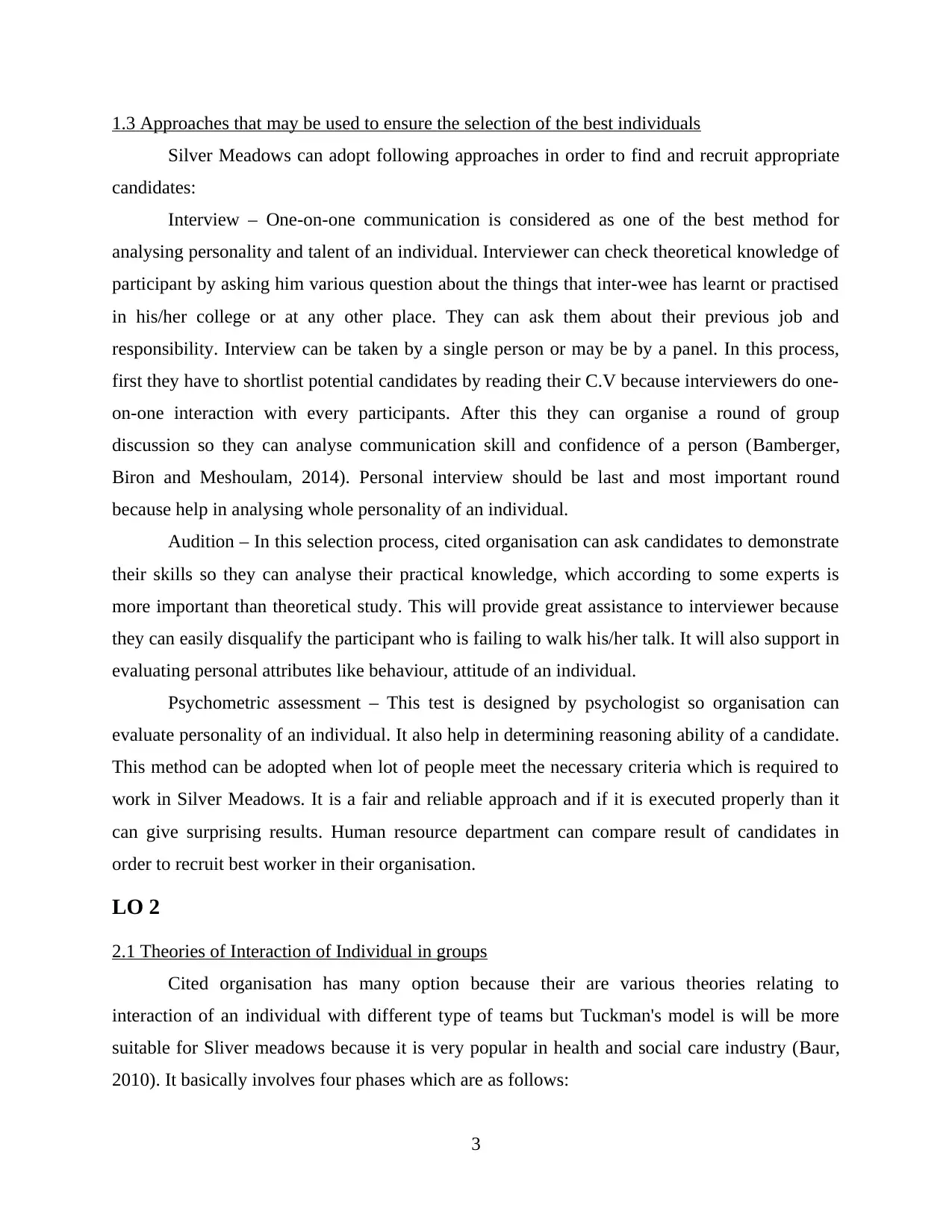
1.3 Approaches that may be used to ensure the selection of the best individuals
Silver Meadows can adopt following approaches in order to find and recruit appropriate
candidates:
Interview – One-on-one communication is considered as one of the best method for
analysing personality and talent of an individual. Interviewer can check theoretical knowledge of
participant by asking him various question about the things that inter-wee has learnt or practised
in his/her college or at any other place. They can ask them about their previous job and
responsibility. Interview can be taken by a single person or may be by a panel. In this process,
first they have to shortlist potential candidates by reading their C.V because interviewers do one-
on-one interaction with every participants. After this they can organise a round of group
discussion so they can analyse communication skill and confidence of a person (Bamberger,
Biron and Meshoulam, 2014). Personal interview should be last and most important round
because help in analysing whole personality of an individual.
Audition – In this selection process, cited organisation can ask candidates to demonstrate
their skills so they can analyse their practical knowledge, which according to some experts is
more important than theoretical study. This will provide great assistance to interviewer because
they can easily disqualify the participant who is failing to walk his/her talk. It will also support in
evaluating personal attributes like behaviour, attitude of an individual.
Psychometric assessment – This test is designed by psychologist so organisation can
evaluate personality of an individual. It also help in determining reasoning ability of a candidate.
This method can be adopted when lot of people meet the necessary criteria which is required to
work in Silver Meadows. It is a fair and reliable approach and if it is executed properly than it
can give surprising results. Human resource department can compare result of candidates in
order to recruit best worker in their organisation.
LO 2
2.1 Theories of Interaction of Individual in groups
Cited organisation has many option because their are various theories relating to
interaction of an individual with different type of teams but Tuckman's model is will be more
suitable for Sliver meadows because it is very popular in health and social care industry (Baur,
2010). It basically involves four phases which are as follows:
3
Silver Meadows can adopt following approaches in order to find and recruit appropriate
candidates:
Interview – One-on-one communication is considered as one of the best method for
analysing personality and talent of an individual. Interviewer can check theoretical knowledge of
participant by asking him various question about the things that inter-wee has learnt or practised
in his/her college or at any other place. They can ask them about their previous job and
responsibility. Interview can be taken by a single person or may be by a panel. In this process,
first they have to shortlist potential candidates by reading their C.V because interviewers do one-
on-one interaction with every participants. After this they can organise a round of group
discussion so they can analyse communication skill and confidence of a person (Bamberger,
Biron and Meshoulam, 2014). Personal interview should be last and most important round
because help in analysing whole personality of an individual.
Audition – In this selection process, cited organisation can ask candidates to demonstrate
their skills so they can analyse their practical knowledge, which according to some experts is
more important than theoretical study. This will provide great assistance to interviewer because
they can easily disqualify the participant who is failing to walk his/her talk. It will also support in
evaluating personal attributes like behaviour, attitude of an individual.
Psychometric assessment – This test is designed by psychologist so organisation can
evaluate personality of an individual. It also help in determining reasoning ability of a candidate.
This method can be adopted when lot of people meet the necessary criteria which is required to
work in Silver Meadows. It is a fair and reliable approach and if it is executed properly than it
can give surprising results. Human resource department can compare result of candidates in
order to recruit best worker in their organisation.
LO 2
2.1 Theories of Interaction of Individual in groups
Cited organisation has many option because their are various theories relating to
interaction of an individual with different type of teams but Tuckman's model is will be more
suitable for Sliver meadows because it is very popular in health and social care industry (Baur,
2010). It basically involves four phases which are as follows:
3
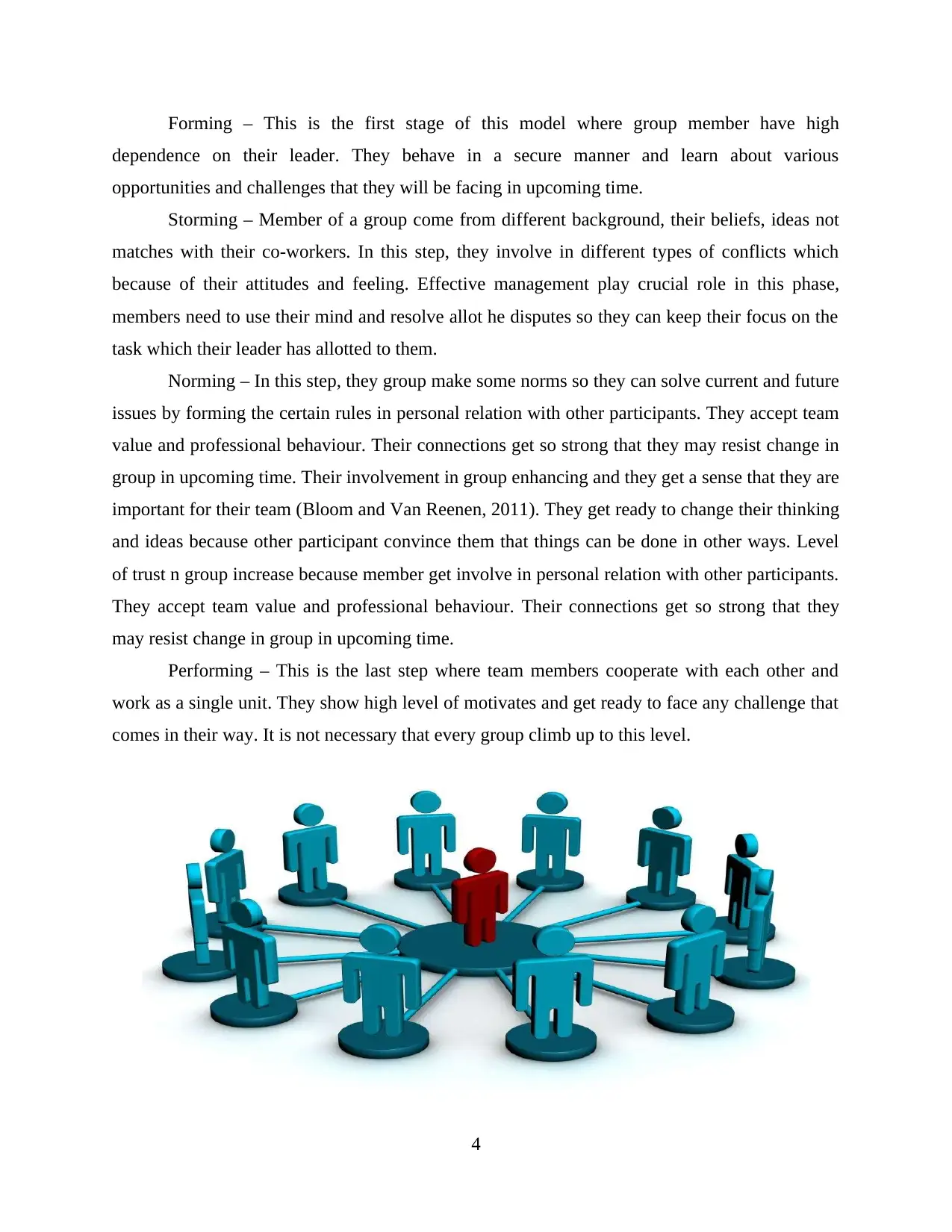
Forming – This is the first stage of this model where group member have high
dependence on their leader. They behave in a secure manner and learn about various
opportunities and challenges that they will be facing in upcoming time.
Storming – Member of a group come from different background, their beliefs, ideas not
matches with their co-workers. In this step, they involve in different types of conflicts which
because of their attitudes and feeling. Effective management play crucial role in this phase,
members need to use their mind and resolve allot he disputes so they can keep their focus on the
task which their leader has allotted to them.
Norming – In this step, they group make some norms so they can solve current and future
issues by forming the certain rules in personal relation with other participants. They accept team
value and professional behaviour. Their connections get so strong that they may resist change in
group in upcoming time. Their involvement in group enhancing and they get a sense that they are
important for their team (Bloom and Van Reenen, 2011). They get ready to change their thinking
and ideas because other participant convince them that things can be done in other ways. Level
of trust n group increase because member get involve in personal relation with other participants.
They accept team value and professional behaviour. Their connections get so strong that they
may resist change in group in upcoming time.
Performing – This is the last step where team members cooperate with each other and
work as a single unit. They show high level of motivates and get ready to face any challenge that
comes in their way. It is not necessary that every group climb up to this level.
4
dependence on their leader. They behave in a secure manner and learn about various
opportunities and challenges that they will be facing in upcoming time.
Storming – Member of a group come from different background, their beliefs, ideas not
matches with their co-workers. In this step, they involve in different types of conflicts which
because of their attitudes and feeling. Effective management play crucial role in this phase,
members need to use their mind and resolve allot he disputes so they can keep their focus on the
task which their leader has allotted to them.
Norming – In this step, they group make some norms so they can solve current and future
issues by forming the certain rules in personal relation with other participants. They accept team
value and professional behaviour. Their connections get so strong that they may resist change in
group in upcoming time. Their involvement in group enhancing and they get a sense that they are
important for their team (Bloom and Van Reenen, 2011). They get ready to change their thinking
and ideas because other participant convince them that things can be done in other ways. Level
of trust n group increase because member get involve in personal relation with other participants.
They accept team value and professional behaviour. Their connections get so strong that they
may resist change in group in upcoming time.
Performing – This is the last step where team members cooperate with each other and
work as a single unit. They show high level of motivates and get ready to face any challenge that
comes in their way. It is not necessary that every group climb up to this level.
4
⊘ This is a preview!⊘
Do you want full access?
Subscribe today to unlock all pages.

Trusted by 1+ million students worldwide
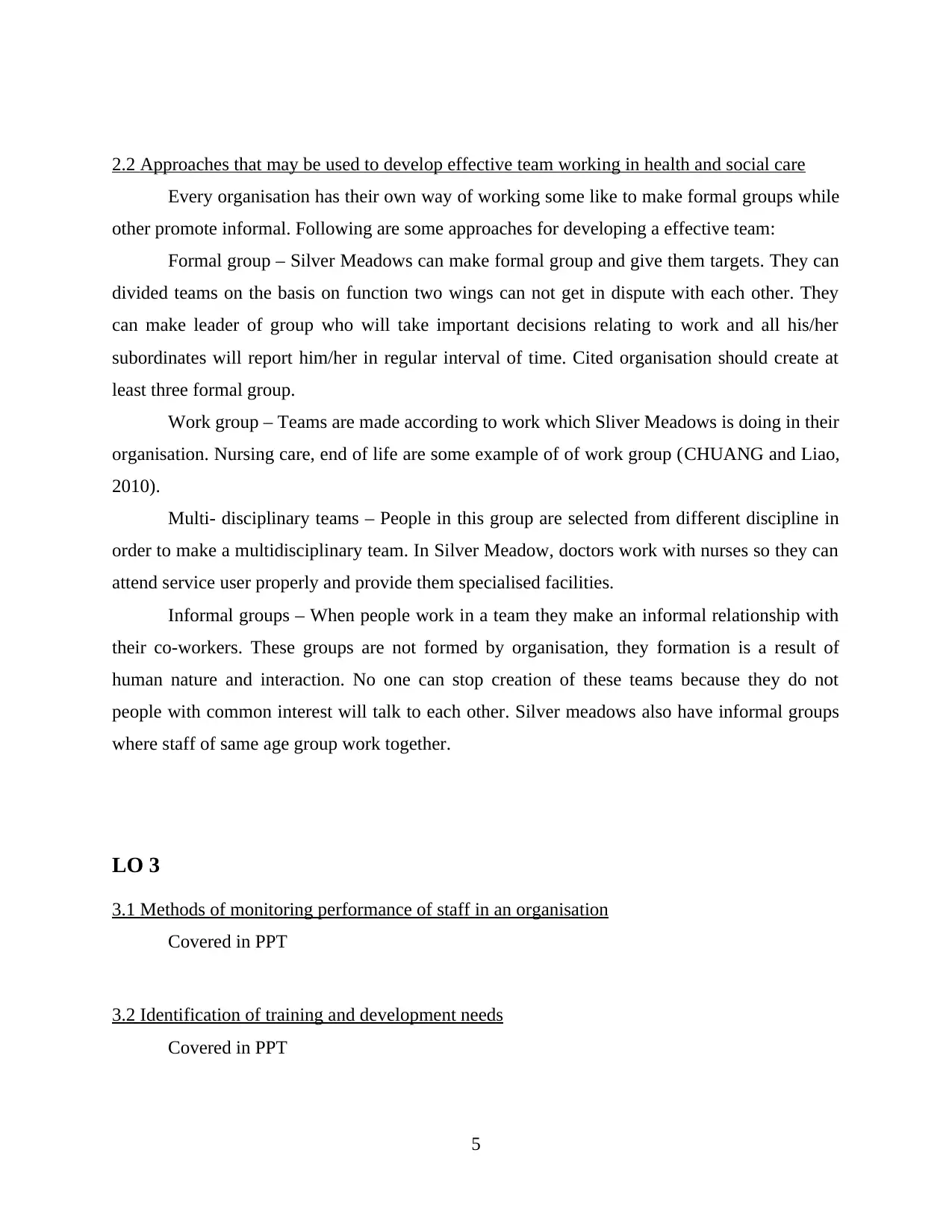
2.2 Approaches that may be used to develop effective team working in health and social care
Every organisation has their own way of working some like to make formal groups while
other promote informal. Following are some approaches for developing a effective team:
Formal group – Silver Meadows can make formal group and give them targets. They can
divided teams on the basis on function two wings can not get in dispute with each other. They
can make leader of group who will take important decisions relating to work and all his/her
subordinates will report him/her in regular interval of time. Cited organisation should create at
least three formal group.
Work group – Teams are made according to work which Sliver Meadows is doing in their
organisation. Nursing care, end of life are some example of of work group (CHUANG and Liao,
2010).
Multi- disciplinary teams – People in this group are selected from different discipline in
order to make a multidisciplinary team. In Silver Meadow, doctors work with nurses so they can
attend service user properly and provide them specialised facilities.
Informal groups – When people work in a team they make an informal relationship with
their co-workers. These groups are not formed by organisation, they formation is a result of
human nature and interaction. No one can stop creation of these teams because they do not
people with common interest will talk to each other. Silver meadows also have informal groups
where staff of same age group work together.
LO 3
3.1 Methods of monitoring performance of staff in an organisation
Covered in PPT
3.2 Identification of training and development needs
Covered in PPT
5
Every organisation has their own way of working some like to make formal groups while
other promote informal. Following are some approaches for developing a effective team:
Formal group – Silver Meadows can make formal group and give them targets. They can
divided teams on the basis on function two wings can not get in dispute with each other. They
can make leader of group who will take important decisions relating to work and all his/her
subordinates will report him/her in regular interval of time. Cited organisation should create at
least three formal group.
Work group – Teams are made according to work which Sliver Meadows is doing in their
organisation. Nursing care, end of life are some example of of work group (CHUANG and Liao,
2010).
Multi- disciplinary teams – People in this group are selected from different discipline in
order to make a multidisciplinary team. In Silver Meadow, doctors work with nurses so they can
attend service user properly and provide them specialised facilities.
Informal groups – When people work in a team they make an informal relationship with
their co-workers. These groups are not formed by organisation, they formation is a result of
human nature and interaction. No one can stop creation of these teams because they do not
people with common interest will talk to each other. Silver meadows also have informal groups
where staff of same age group work together.
LO 3
3.1 Methods of monitoring performance of staff in an organisation
Covered in PPT
3.2 Identification of training and development needs
Covered in PPT
5
Paraphrase This Document
Need a fresh take? Get an instant paraphrase of this document with our AI Paraphraser
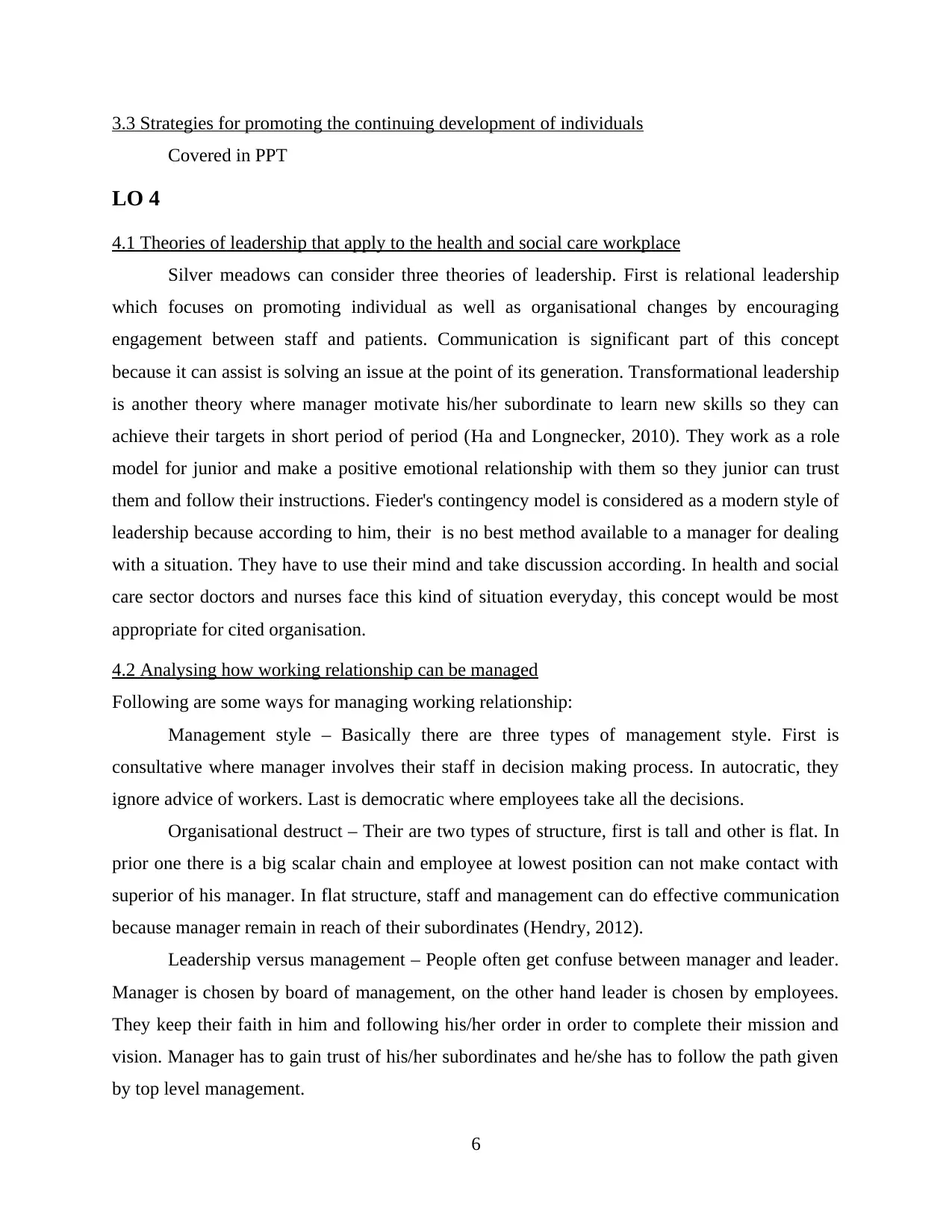
3.3 Strategies for promoting the continuing development of individuals
Covered in PPT
LO 4
4.1 Theories of leadership that apply to the health and social care workplace
Silver meadows can consider three theories of leadership. First is relational leadership
which focuses on promoting individual as well as organisational changes by encouraging
engagement between staff and patients. Communication is significant part of this concept
because it can assist is solving an issue at the point of its generation. Transformational leadership
is another theory where manager motivate his/her subordinate to learn new skills so they can
achieve their targets in short period of period (Ha and Longnecker, 2010). They work as a role
model for junior and make a positive emotional relationship with them so they junior can trust
them and follow their instructions. Fieder's contingency model is considered as a modern style of
leadership because according to him, their is no best method available to a manager for dealing
with a situation. They have to use their mind and take discussion according. In health and social
care sector doctors and nurses face this kind of situation everyday, this concept would be most
appropriate for cited organisation.
4.2 Analysing how working relationship can be managed
Following are some ways for managing working relationship:
Management style – Basically there are three types of management style. First is
consultative where manager involves their staff in decision making process. In autocratic, they
ignore advice of workers. Last is democratic where employees take all the decisions.
Organisational destruct – Their are two types of structure, first is tall and other is flat. In
prior one there is a big scalar chain and employee at lowest position can not make contact with
superior of his manager. In flat structure, staff and management can do effective communication
because manager remain in reach of their subordinates (Hendry, 2012).
Leadership versus management – People often get confuse between manager and leader.
Manager is chosen by board of management, on the other hand leader is chosen by employees.
They keep their faith in him and following his/her order in order to complete their mission and
vision. Manager has to gain trust of his/her subordinates and he/she has to follow the path given
by top level management.
6
Covered in PPT
LO 4
4.1 Theories of leadership that apply to the health and social care workplace
Silver meadows can consider three theories of leadership. First is relational leadership
which focuses on promoting individual as well as organisational changes by encouraging
engagement between staff and patients. Communication is significant part of this concept
because it can assist is solving an issue at the point of its generation. Transformational leadership
is another theory where manager motivate his/her subordinate to learn new skills so they can
achieve their targets in short period of period (Ha and Longnecker, 2010). They work as a role
model for junior and make a positive emotional relationship with them so they junior can trust
them and follow their instructions. Fieder's contingency model is considered as a modern style of
leadership because according to him, their is no best method available to a manager for dealing
with a situation. They have to use their mind and take discussion according. In health and social
care sector doctors and nurses face this kind of situation everyday, this concept would be most
appropriate for cited organisation.
4.2 Analysing how working relationship can be managed
Following are some ways for managing working relationship:
Management style – Basically there are three types of management style. First is
consultative where manager involves their staff in decision making process. In autocratic, they
ignore advice of workers. Last is democratic where employees take all the decisions.
Organisational destruct – Their are two types of structure, first is tall and other is flat. In
prior one there is a big scalar chain and employee at lowest position can not make contact with
superior of his manager. In flat structure, staff and management can do effective communication
because manager remain in reach of their subordinates (Hendry, 2012).
Leadership versus management – People often get confuse between manager and leader.
Manager is chosen by board of management, on the other hand leader is chosen by employees.
They keep their faith in him and following his/her order in order to complete their mission and
vision. Manager has to gain trust of his/her subordinates and he/she has to follow the path given
by top level management.
6
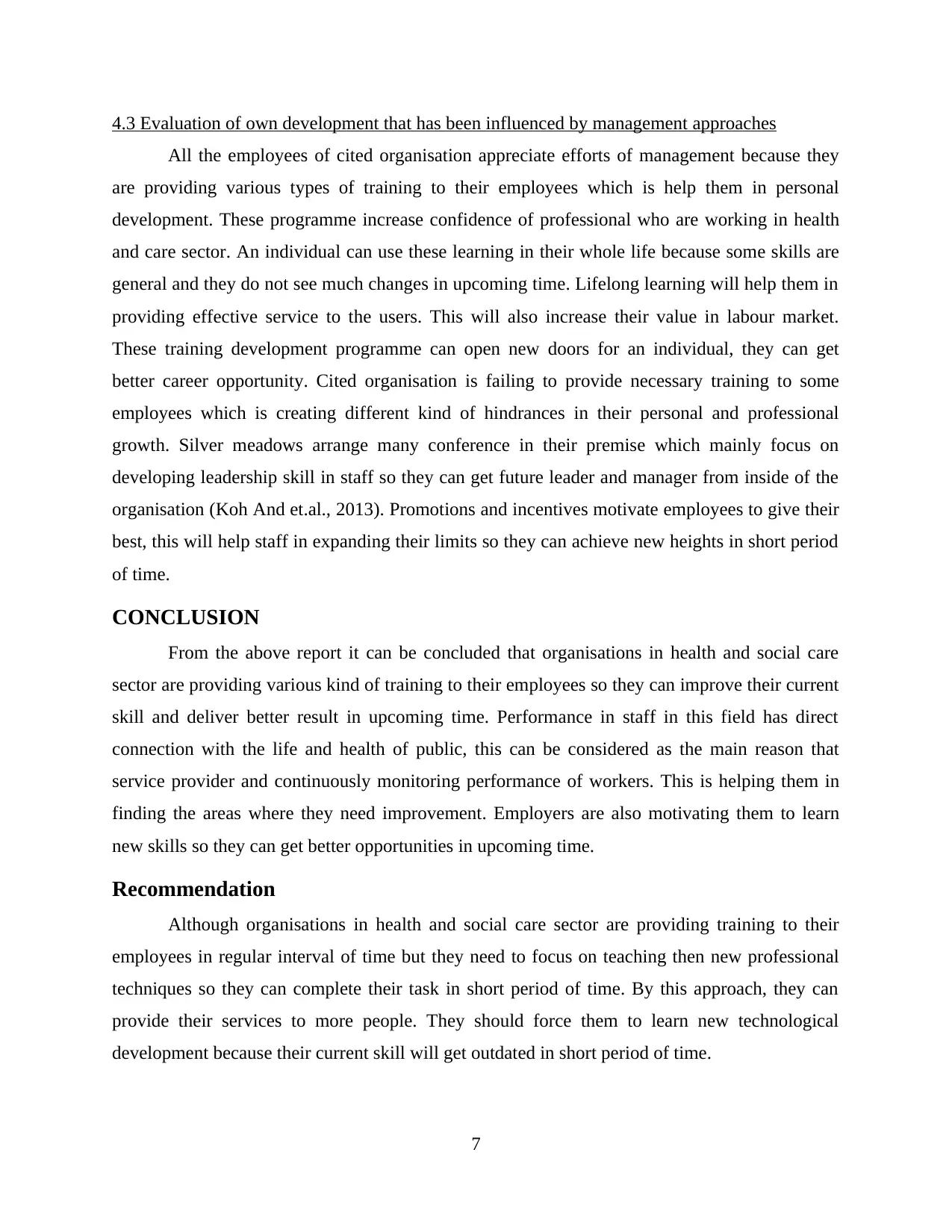
4.3 Evaluation of own development that has been influenced by management approaches
All the employees of cited organisation appreciate efforts of management because they
are providing various types of training to their employees which is help them in personal
development. These programme increase confidence of professional who are working in health
and care sector. An individual can use these learning in their whole life because some skills are
general and they do not see much changes in upcoming time. Lifelong learning will help them in
providing effective service to the users. This will also increase their value in labour market.
These training development programme can open new doors for an individual, they can get
better career opportunity. Cited organisation is failing to provide necessary training to some
employees which is creating different kind of hindrances in their personal and professional
growth. Silver meadows arrange many conference in their premise which mainly focus on
developing leadership skill in staff so they can get future leader and manager from inside of the
organisation (Koh And et.al., 2013). Promotions and incentives motivate employees to give their
best, this will help staff in expanding their limits so they can achieve new heights in short period
of time.
CONCLUSION
From the above report it can be concluded that organisations in health and social care
sector are providing various kind of training to their employees so they can improve their current
skill and deliver better result in upcoming time. Performance in staff in this field has direct
connection with the life and health of public, this can be considered as the main reason that
service provider and continuously monitoring performance of workers. This is helping them in
finding the areas where they need improvement. Employers are also motivating them to learn
new skills so they can get better opportunities in upcoming time.
Recommendation
Although organisations in health and social care sector are providing training to their
employees in regular interval of time but they need to focus on teaching then new professional
techniques so they can complete their task in short period of time. By this approach, they can
provide their services to more people. They should force them to learn new technological
development because their current skill will get outdated in short period of time.
7
All the employees of cited organisation appreciate efforts of management because they
are providing various types of training to their employees which is help them in personal
development. These programme increase confidence of professional who are working in health
and care sector. An individual can use these learning in their whole life because some skills are
general and they do not see much changes in upcoming time. Lifelong learning will help them in
providing effective service to the users. This will also increase their value in labour market.
These training development programme can open new doors for an individual, they can get
better career opportunity. Cited organisation is failing to provide necessary training to some
employees which is creating different kind of hindrances in their personal and professional
growth. Silver meadows arrange many conference in their premise which mainly focus on
developing leadership skill in staff so they can get future leader and manager from inside of the
organisation (Koh And et.al., 2013). Promotions and incentives motivate employees to give their
best, this will help staff in expanding their limits so they can achieve new heights in short period
of time.
CONCLUSION
From the above report it can be concluded that organisations in health and social care
sector are providing various kind of training to their employees so they can improve their current
skill and deliver better result in upcoming time. Performance in staff in this field has direct
connection with the life and health of public, this can be considered as the main reason that
service provider and continuously monitoring performance of workers. This is helping them in
finding the areas where they need improvement. Employers are also motivating them to learn
new skills so they can get better opportunities in upcoming time.
Recommendation
Although organisations in health and social care sector are providing training to their
employees in regular interval of time but they need to focus on teaching then new professional
techniques so they can complete their task in short period of time. By this approach, they can
provide their services to more people. They should force them to learn new technological
development because their current skill will get outdated in short period of time.
7
⊘ This is a preview!⊘
Do you want full access?
Subscribe today to unlock all pages.

Trusted by 1+ million students worldwide
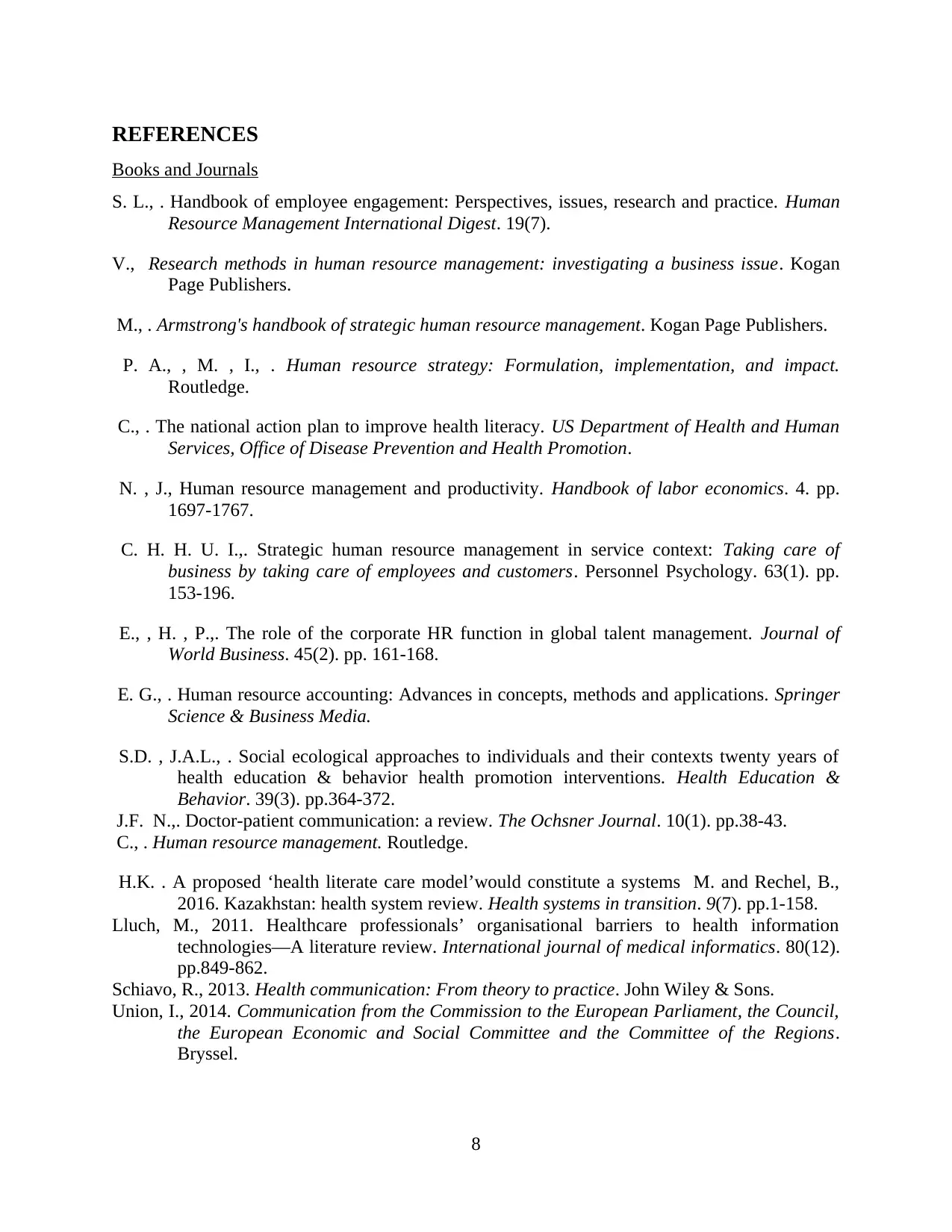
REFERENCES
Books and Journals
S. L., . Handbook of employee engagement: Perspectives, issues, research and practice. Human
Resource Management International Digest. 19(7).
V., Research methods in human resource management: investigating a business issue. Kogan
Page Publishers.
M., . Armstrong's handbook of strategic human resource management. Kogan Page Publishers.
P. A., , M. , I., . Human resource strategy: Formulation, implementation, and impact.
Routledge.
C., . The national action plan to improve health literacy. US Department of Health and Human
Services, Office of Disease Prevention and Health Promotion.
N. , J., Human resource management and productivity. Handbook of labor economics. 4. pp.
1697-1767.
C. H. H. U. I.,. Strategic human resource management in service context: Taking care of
business by taking care of employees and customers. Personnel Psychology. 63(1). pp.
153-196.
E., , H. , P.,. The role of the corporate HR function in global talent management. Journal of
World Business. 45(2). pp. 161-168.
E. G., . Human resource accounting: Advances in concepts, methods and applications. Springer
Science & Business Media.
S.D. , J.A.L., . Social ecological approaches to individuals and their contexts twenty years of
health education & behavior health promotion interventions. Health Education &
Behavior. 39(3). pp.364-372.
J.F. N.,. Doctor-patient communication: a review. The Ochsner Journal. 10(1). pp.38-43.
C., . Human resource management. Routledge.
H.K. . A proposed ‘health literate care model’would constitute a systems M. and Rechel, B.,
2016. Kazakhstan: health system review. Health systems in transition. 9(7). pp.1-158.
Lluch, M., 2011. Healthcare professionals’ organisational barriers to health information
technologies—A literature review. International journal of medical informatics. 80(12).
pp.849-862.
Schiavo, R., 2013. Health communication: From theory to practice. John Wiley & Sons.
Union, I., 2014. Communication from the Commission to the European Parliament, the Council,
the European Economic and Social Committee and the Committee of the Regions.
Bryssel.
8
Books and Journals
S. L., . Handbook of employee engagement: Perspectives, issues, research and practice. Human
Resource Management International Digest. 19(7).
V., Research methods in human resource management: investigating a business issue. Kogan
Page Publishers.
M., . Armstrong's handbook of strategic human resource management. Kogan Page Publishers.
P. A., , M. , I., . Human resource strategy: Formulation, implementation, and impact.
Routledge.
C., . The national action plan to improve health literacy. US Department of Health and Human
Services, Office of Disease Prevention and Health Promotion.
N. , J., Human resource management and productivity. Handbook of labor economics. 4. pp.
1697-1767.
C. H. H. U. I.,. Strategic human resource management in service context: Taking care of
business by taking care of employees and customers. Personnel Psychology. 63(1). pp.
153-196.
E., , H. , P.,. The role of the corporate HR function in global talent management. Journal of
World Business. 45(2). pp. 161-168.
E. G., . Human resource accounting: Advances in concepts, methods and applications. Springer
Science & Business Media.
S.D. , J.A.L., . Social ecological approaches to individuals and their contexts twenty years of
health education & behavior health promotion interventions. Health Education &
Behavior. 39(3). pp.364-372.
J.F. N.,. Doctor-patient communication: a review. The Ochsner Journal. 10(1). pp.38-43.
C., . Human resource management. Routledge.
H.K. . A proposed ‘health literate care model’would constitute a systems M. and Rechel, B.,
2016. Kazakhstan: health system review. Health systems in transition. 9(7). pp.1-158.
Lluch, M., 2011. Healthcare professionals’ organisational barriers to health information
technologies—A literature review. International journal of medical informatics. 80(12).
pp.849-862.
Schiavo, R., 2013. Health communication: From theory to practice. John Wiley & Sons.
Union, I., 2014. Communication from the Commission to the European Parliament, the Council,
the European Economic and Social Committee and the Committee of the Regions.
Bryssel.
8
Paraphrase This Document
Need a fresh take? Get an instant paraphrase of this document with our AI Paraphraser
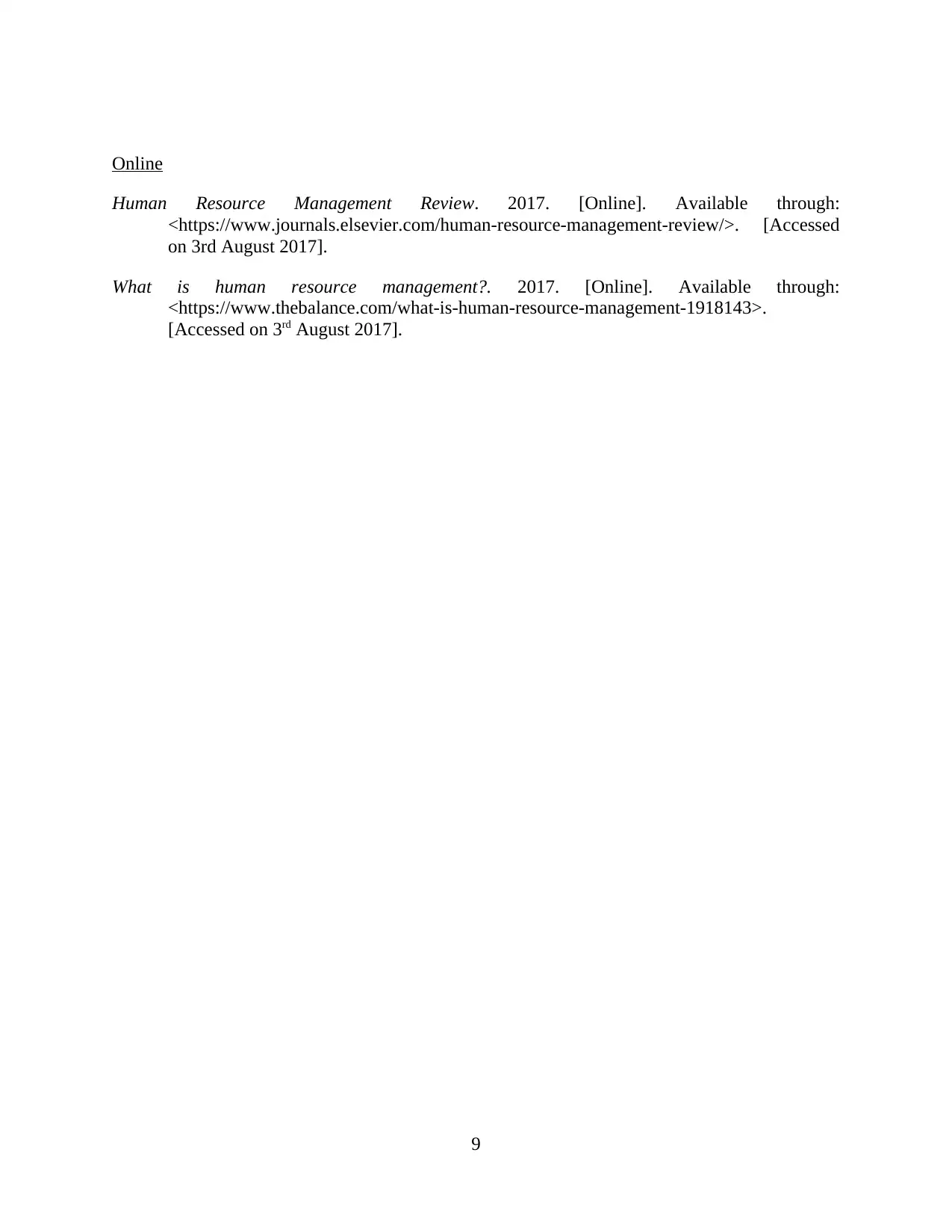
Online
Human Resource Management Review. 2017. [Online]. Available through:
<https://www.journals.elsevier.com/human-resource-management-review/>. [Accessed
on 3rd August 2017].
What is human resource management?. 2017. [Online]. Available through:
<https://www.thebalance.com/what-is-human-resource-management-1918143>.
[Accessed on 3rd August 2017].
9
Human Resource Management Review. 2017. [Online]. Available through:
<https://www.journals.elsevier.com/human-resource-management-review/>. [Accessed
on 3rd August 2017].
What is human resource management?. 2017. [Online]. Available through:
<https://www.thebalance.com/what-is-human-resource-management-1918143>.
[Accessed on 3rd August 2017].
9
1 out of 11
Related Documents
Your All-in-One AI-Powered Toolkit for Academic Success.
+13062052269
info@desklib.com
Available 24*7 on WhatsApp / Email
![[object Object]](/_next/static/media/star-bottom.7253800d.svg)
Unlock your academic potential
Copyright © 2020–2025 A2Z Services. All Rights Reserved. Developed and managed by ZUCOL.





